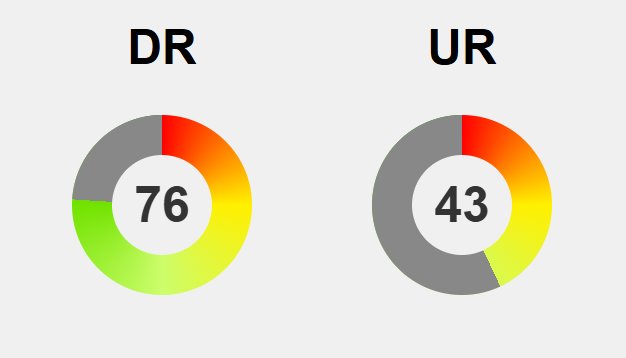Imagine a simple yet profound way to gauge your heart’s health—how quickly it returns to normal after exercise. A swift recovery signals resilience and good autonomic nervous system function, but what lurks beneath a sluggish response? Could delayed heart rate recovery be silently revealing risks like early cardiovascular issues or hidden stress imbalances? As research shows, this measure is more than fitness—it’s a window into your body’s ability to handle stress and recover from exertion. Advances in wearable tech now make tracking HRR accessible daily, transforming it into a powerful, proactive health tool. But what does a slow recovery truly signify? And how can early detection of these subtle signs help prevent future health crises? This evolving landscape promises that understanding and monitoring HRR could become central to personalized, preventive care—empowering you to spot hidden risks before they become visible symptoms.
Unlocking Your Heart’s Secrets Through Recovery Insights
When you finish exercising, your heart doesn’t simply stop; it continues to beat and gradually slow down until it reaches a resting rate. This process, known as heart rate recovery (HRR), offers more than just a number on a monitor—it provides a window into your overall health. HRR measures how quickly your heart rate drops after stopping activity, and this speed reflects how well your cardiovascular and nervous systems are functioning together.
A quick HRR typically signals a healthy heart and a well-balanced autonomic nervous system, especially the parasympathetic branch that helps calm the body after stress. Conversely, if your heart rate remains elevated long after you’ve finished exercising, it might indicate underlying issues. A sluggish recovery can be linked to poor fitness, heightened stress levels, or more serious conditions like early signs of heart disease.
Research shows that delayed HRR isn’t just about fitness; it can predict future health risks. People with slower recovery times are more likely to experience cardiovascular events down the line. This makes HRR a simple yet powerful tool for early detection, even before symptoms appear. It’s a way to gauge how resilient your heart and nervous system are, giving you insights into potential vulnerabilities.
Understanding HRR helps you see your body’s response to exertion and recovery. When your heart can efficiently shift from activity to rest, it indicates good autonomic regulation—crucial for adapting to daily stressors and maintaining overall health. Recognizing variations in HRR among individuals is key; factors like age, fitness level, medication, and genetics influence recovery times. A slower HRR doesn’t automatically mean trouble but should be interpreted in context.
What makes HRR especially valuable is its ability to reveal hidden risks beneath the surface. A sluggish recovery can be an early warning sign that your autonomic nervous system isn’t functioning optimally. This may be a precursor to more serious issues, such as increased cardiovascular stress or imbalance, developing silently over time.
Monitoring HRR isn’t about overreacting to a number but about understanding what it says about your body’s resilience. When your heart recovers quickly, it’s a sign that your cardiovascular system handles stress well. If recovery slows unexpectedly, it could be a cue to pay closer attention, perhaps adjusting your activity, managing stress better, or consulting a healthcare professional.
Recognizing HRR’s significance encourages a proactive approach to health. This simple measure offers valuable insights into your body’s ability to recover from exertion and adapt to stress—key factors for long-term wellbeing. Keeping an eye on your HRR can help you catch early signs of imbalance and support healthier, more resilient heart function over time.
Tracing the Evolution of Heart Rate Recovery Research
The understanding of heart rate recovery (HRR) has developed considerably over the past few decades. Early observations revealed that athletes and physically fit individuals tended to see their heart rates decline more rapidly after exercise compared to sedentary people. This simple difference caught researchers’ attention, suggesting that HRR could serve as an accessible marker of cardiovascular fitness. Over time, scientists recognized that the speed of recovery was more than just a performance indicator—it reflected the complex interplay between the heart and the autonomic nervous system, which regulates involuntary functions like heartbeat and respiration.
In the 1980s and 1990s, research began to uncover that HRR could do more than measure fitness levels; it might also predict future health risks. Studies showed that slower recovery times correlated with higher chances of cardiac events and increased mortality. This evidence shifted the view of HRR from a performance metric to a valuable, non-invasive tool for assessing cardiovascular health and early warning signs of underlying issues. These insights laid the groundwork for integrating HRR into clinical risk assessments.
Technological advances in exercise testing played a key role in refining our understanding of HRR. The development of standardized treadmill and cycle ergometer protocols allowed scientists to gather more consistent data across diverse populations. This consistency revealed clear patterns—such as how age, sex, and baseline fitness influence recovery times—and helped establish benchmarks for what constitutes healthy versus concerning HRR. These improvements made it possible to compare recovery data more reliably, deepening our grasp of what healthy autonomic function looks like at different life stages.
As research into the autonomic nervous system progressed, it became clearer that HRR was a reflection of the balance between sympathetic activation (which energizes the body during exercise) and parasympathetic reactivation (which calms it down afterward). Disruptions in this balance—caused by stress, aging, or disease—could slow recovery and serve as early indicators of autonomic dysfunction. Recognizing these connections underscored HRR’s potential as an early marker for identifying hidden health risks before symptoms even appeared.
Over time, the evidence accumulated that slow HRR could signal underlying autonomic issues that might not be immediately apparent. People with delayed recovery often showed signs of cardiovascular stress or imbalance, even if they felt fine. This shifted the focus toward using HRR as part of preventive medicine, rather than just a fitness test. Today, HRR is viewed as a vital sign of how well the autonomic nervous system adapts to stress, offering a window into underlying health that might otherwise go unnoticed.
The integration of HRR into routine health assessments has been accelerated by the rise of wearable technology. Devices like smartwatches now track recovery times in real-world settings, making it easier to monitor trends over days, weeks, and months. This democratization of data empowers individuals to understand their own health better and encourages proactive management. As technology continues to evolve, so does the potential for HRR to become an everyday tool for early detection and ongoing health monitoring, bridging the gap between clinical insights and personal wellness.
The Modern Role of Heart Rate Recovery in Health Assessment
Today, measuring heart rate recovery (HRR) has become more precise and accessible thanks to technological advancements. In clinics, healthcare providers routinely use treadmill or cycle ergometer stress tests, where they monitor how quickly the heart rate drops during the cool-down phase. These controlled environments provide standardized measurements, giving doctors a clearer picture of autonomic function and overall cardiovascular health. Consistent protocols across facilities help identify early signs of potential issues before symptoms even appear.
On the consumer side, wearable devices like smartwatches and fitness trackers now make HRR tracking part of everyday life. These gadgets use optical sensors to monitor heart rate during and after workouts, offering real-time feedback on how quickly the heart recovers. Many apps analyze this data, giving personalized insights that encourage people to pay closer attention to their heart health outside clinical settings. This ease of access turns HRR into a practical tool for daily wellness and fitness routines.
Different age groups and populations show varying benchmarks for healthy HRR. Younger individuals tend to recover faster, reflecting more resilient autonomic nervous systems, while older adults often experience slower recovery times. Sex differences also influence recovery patterns, with some studies suggesting hormonal and physiological factors play a role. Lifestyle choices, including activity levels, diet, and stress management, further shape these recovery patterns across diverse communities. Recognizing these differences helps tailor assessments and set realistic expectations for individual health.
While HRR is gaining popularity, experts continue debating its predictive power. Many studies support HRR as an indicator of cardiovascular risk, but factors like age, medications, and stress can influence recovery times. This variability underscores the need for better standardization and validation across different populations. Despite these concerns, the growing body of evidence suggests that, when interpreted in context, HRR can be a valuable component of comprehensive health assessments.
Guidelines from organizations such as the American Heart Association now recommend including HRR in exercise stress testing protocols, with specific thresholds to flag potential risks. Ongoing technological innovations—like more sophisticated wearables and data analytics—are enhancing the accuracy and usefulness of HRR measurements. As research advances, HRR is poised to become a routine part of health monitoring, helping individuals and clinicians identify early signs of imbalance and maintain cardiovascular resilience more effectively.
For those interested in exploring how heart rate recovery can be integrated into their health routine, learning more about comprehensive tools and resources can be beneficial. Understanding the full scope of HRR and how to interpret its data is essential for making informed decisions about cardiovascular wellness. To delve deeper into this topic, you can visit this detailed guide on heart rate recovery and discover practical ways to incorporate HRR insights into your daily health management.
Transforming Heart Rate Recovery Data into Practical Health Strategies
Monitoring your heart rate recovery (HRR) offers a straightforward way to gauge your cardiovascular resilience and overall heart health. When you pay attention to how quickly your heart slows after exercise, you gain a snapshot of your autonomic nervous system’s effectiveness in calming your body. A quick recovery generally indicates a resilient heart and nervous system, supporting better stress management and physical fitness.
Using HRR data in daily life can be surprisingly empowering. If your recovery is consistently fast, it suggests your heart handles stress well and your body recovers efficiently. This can motivate you to maintain or even increase your activity levels, knowing your body responds positively to exertion. Conversely, a sluggish HRR might signal the need to adjust your routines, perhaps by incorporating more rest, practicing stress reduction techniques, or improving sleep habits.
For those with existing health issues, HRR provides valuable insights beyond standard checkups. A slow recovery during routine assessments could alert your healthcare provider to underlying autonomic imbalances or early signs of cardiovascular stress. This early warning allows for tailored interventions, lifestyle adjustments, and closer monitoring to prevent future complications.
Wearable technology has made tracking HRR outside clinical settings easier than ever. Devices like smartwatches and fitness trackers automatically monitor your heart rate during workouts and recovery periods, providing instant feedback. Over time, analyzing these trends can help you optimize your exercise intensity, avoid overtraining, and spot unusual patterns that may warrant medical attention.
Incorporating HRR into your routine doesn’t require specialized knowledge or equipment—just paying attention to how quickly your heart returns to normal after activity. Recognizing these patterns over days or weeks reveals whether your autonomic nervous system is adapting well or showing signs of stress or fatigue. This simple insight can inform smarter decisions about activity levels, stress management, and when to seek medical advice.
Ultimately, tracking HRR encourages a proactive approach to health. It transforms a basic physiological response into a powerful tool for early detection and ongoing management of your heart health. By staying attuned to your recovery times, you can catch potential issues early, make informed lifestyle choices, and support long-term resilience—giving you greater confidence in your well-being every day.
Future Horizons: Advancing Heart Rate Recovery for Better Wellbeing
Looking ahead, the potential of heart rate recovery (HRR) as a vital tool for health monitoring is promising. Advances in wearable technology and data analysis are enabling more precise, real-time insights into how our autonomic nervous system functions. These innovations could lead to earlier detection of risks, giving individuals the chance to act before issues escalate. As research continues, HRR is likely to become a standard part of routine health checks and fitness routines, evolving from an occasional measurement into a reliable indicator of cardiovascular resilience.
Emerging studies are exploring how HRR interacts with other health markers like blood pressure, sleep quality, and metabolic health. Combining these data points can create personalized risk profiles, allowing targeted interventions that address specific vulnerabilities. This integrated approach enhances early detection and supports customized lifestyle changes and treatments, helping optimize heart health over time. Making these insights accessible and actionable for everyone will be crucial in shifting toward more preventative, patient-centered care.
Standardization and validation of HRR measurements across diverse populations remain essential. Factors such as age, fitness level, medication, and stress influence recovery times, so establishing universal benchmarks will improve accuracy and trust in HRR as a health indicator. Developing these standards ensures that assessments are meaningful regardless of individual differences, allowing clinicians and individuals to interpret HRR data confidently and effectively. This progress will strengthen HRR’s role as a reliable early warning sign.
The integration of artificial intelligence and machine learning opens exciting possibilities for the future. These tools can analyze vast amounts of recovery data, identify subtle patterns, and predict health risks before symptoms appear. Such predictive analytics could revolutionize preventive care, shifting focus from treatment to early intervention. Continuous, automated monitoring through smart devices will provide real-time insights, empowering people to make informed decisions and seek help when needed.
Research into how lifestyle choices, medications, and stress management influence HRR over time will deepen our understanding of its full potential. Collaboration among scientists, healthcare providers, and technology developers will accelerate innovations, ensuring that new tools are scientifically sound and practically useful. This ongoing effort promises to uncover novel ways to safeguard long-term heart health, making HRR a more effective, accessible component of everyday health management.
Efforts to make HRR measurement more standardized and reliable will lead to broader adoption. As validation improves, HRR can serve as a straightforward, everyday indicator—integrated into apps, wearables, and health routines—that helps detect hidden risks early. This proactive approach can reduce the burden of silent, developing problems, allowing individuals to maintain resilience and prevent serious illness before it takes hold.
The future of HRR research and technology points toward a more connected, responsive approach to health. By harnessing innovations in data analysis and wearable tech, HRR can become a powerful, everyday tool that supports early detection, healthy choices, and long-term resilience. This shift toward personalized, preventive care will help people stay healthier longer, with fewer surprises along the way.






